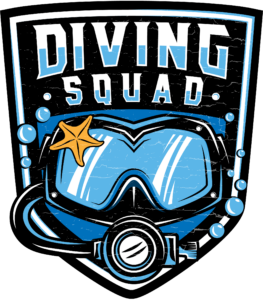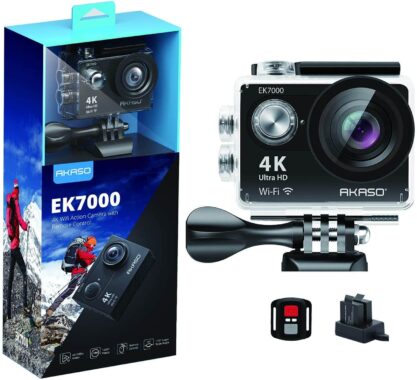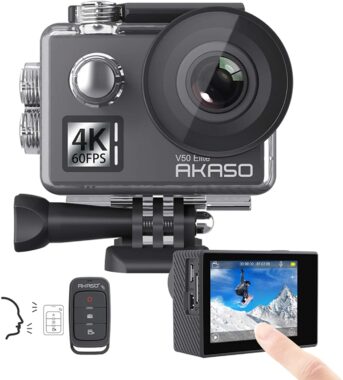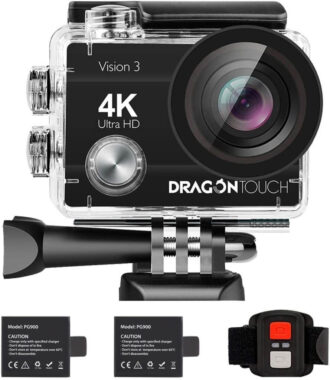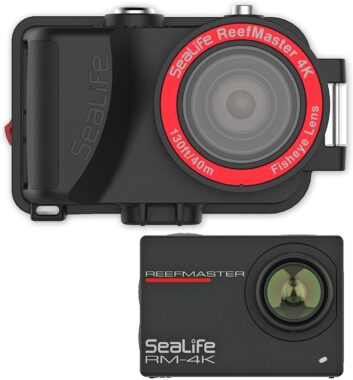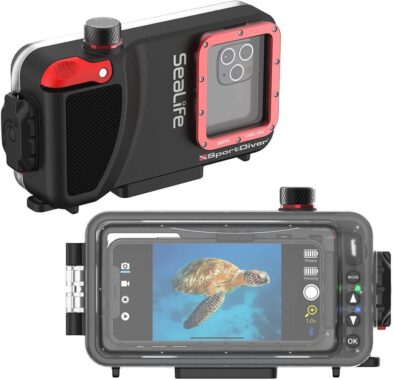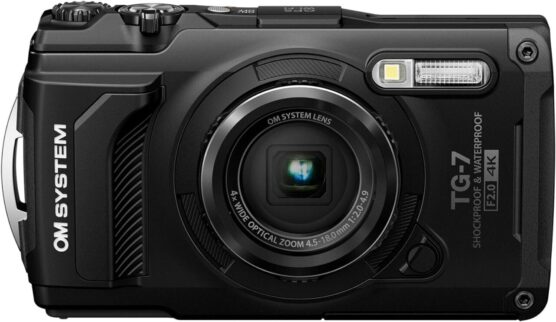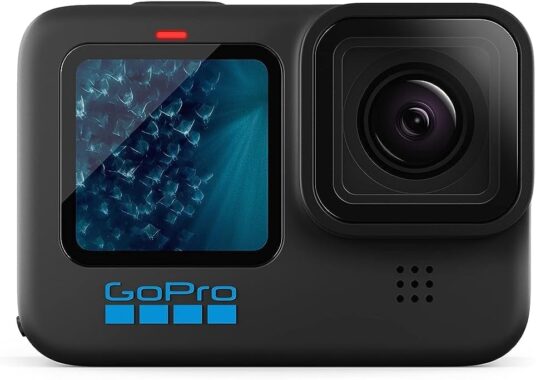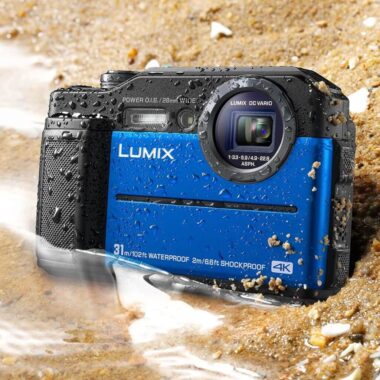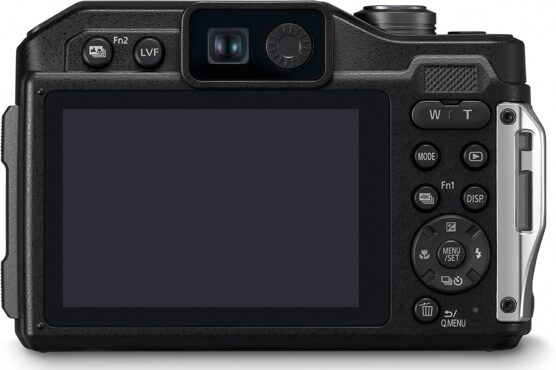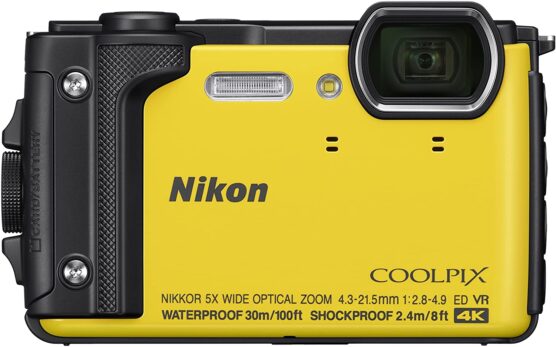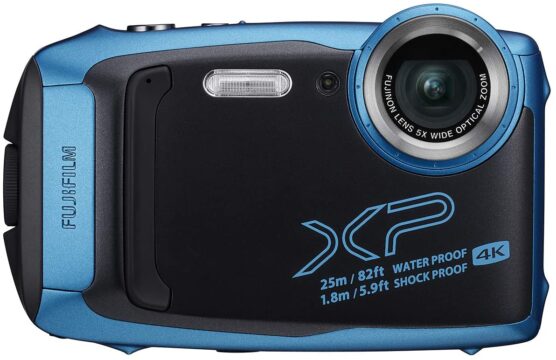
10 Best Cheap Underwater Cameras of 2024
(If you’re looking for high quality underwater cameras designed especially for scuba diving, check out our page: Best Underwater Cameras)
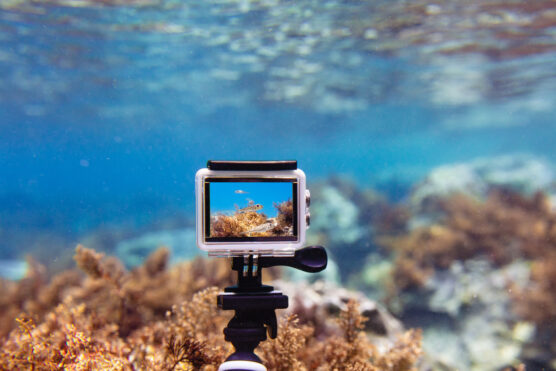
It’s easy to feel overwhelmed when trying to find the best cheap underwater camera.
With so – many – options (!) for cheap diving cameras; each with numerous specs and features to compare, how the hell do you separate the truth from the hype?
Never fear! We’ve scoured the seven seas to bring you the 10 best budget underwater cameras of 2024; having tried and tested dozens of the things.
The cheapest underwater cameras are tiny action cams with waterproof housing that start at around $70 -$150; we start our reviews with these and move onto more sophisticated underwater cams in the $200 – $400 range.
Use the QUICK LOOK section below to take a fast glance at the best budget underwater cameras currently available or scroll down further to read our Detailed Reviews.

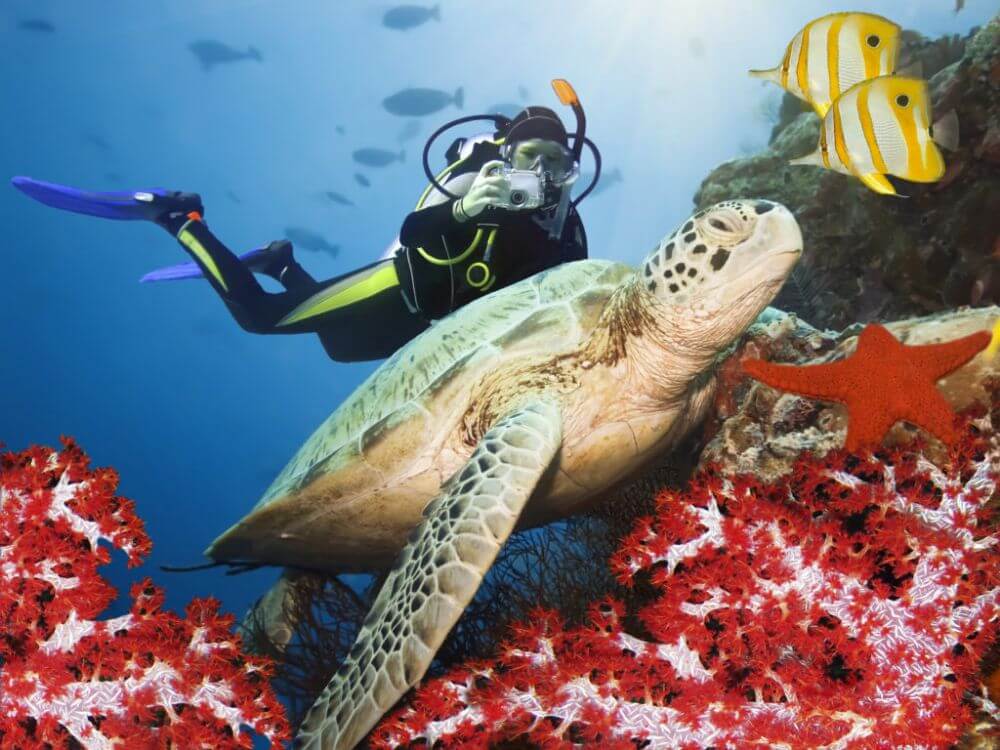
QUICK LOOK - Cheap Underwater Cameras:
- Cheapest Underwater Camera: Akaso EK7000
- TOP PICK: Akaso V50 Elite
- Best Value: Dragon Touch
- Cheap Underwater Camera for Divers: Sealife Reefmaster RM-4K
- Underwater Case for SmartPhones: Sealife SportDiver
- Best for Macro (Tiny Subjects): Olympus Tough TG-7
- Best Underwater Action Camera: GoPro Hero 11
- Best Snorkeling Camera: Panasonic Lumix TS7
- Extra Durable Underwater Camera: Nikon Coolpix W300
- Cheap Waterproof Cam with no need for UW Housing: FuijiFilm Finepix XP140
REVIEWS:
1) Cheapest Underwater Camera: Akaso EK7000
The Akaso EK7000 has been the top selling cheap underwater camera on amazon for sometime now, with thousands of positive reviews.
One of the reasons for its popularity is how affordable it is; it’s actually the cheapest of all the underwater cameras we’re reviewing.
Despite this, it has truly been designed with underwater use in mind; being waterproof to 100ft / 30m when sealed in its included underwater casing.
It’s insanely cheap but this little action camera packs a great punch; especially with regards to video which it can shoot at up to 4K at 30fps; on par with the capabilities of many more expensive cameras.
The 12mp sensor lets you snap decent photos and there’s also several handy features like photo boost, time lapse and looping as well as built in WiFi that lets you share to the Akaso app.
The EK7000 is the cheapest model on a line of cheap underwater cams designed by Akaso. On the other end of that line and costing $70 more is the Akaso V50 Elite: it’s vastly superior so we’ve reviewed it next.
Where to Buy:
PROS:
- Cheapest option.
- Can go to 100ft / 30m.
- Great video capabilities at 4k 30fps.
- 12mp sensor for decent photo resolution.
CONS:
- No electronic image stabilisation.
- Fairly small image sensor (only 12mp).
- Can’t shoot 4k at 60 fps
…all of these cons are resolved by the Akaso V50 Elite!
2) Top Pick: Akaso V50 Elite
The Akaso V50 Elite is similar in appearance to it’s cheaper cousin; the EK7000, but in terms of performance it’s so much more.
It can shoot 4K at 60fps – that’s twice as many frames per second as the EK7000; resulting in smoother video motion. Next, unlike the 12mp photo resolution of the EK7000, the V50 Elite boasts 20mp photo resolution
Seeing a pattern here? Everything the Akaso EK7000 can do, the V50 Elite can do better! The same applies to depth rating, as within it’s underwater housing, you can can take the V50 Elite all the way down to 131 ft / 40m.
It also features electronic image stabilisation which is exceptionally useful underwater where your camera movements are more likely to be shaky.
All these great features combined with an extremely low price (it’s the third cheapest camera in this article!), make the Akaso V50 Elite our favourite cheap underwater camera – it’s affordable yet highly effective
That said, there are better quality underwater cameras available if you’re willing to spend a few hundred bucks more. We’ve covered them a little further down in this article.
Where to Buy:
PROS:
- 4k 60fps.
- 20mp sensor.
- Can go to 131ft / 40m.
- Electronic image stabilisation.
- Distortion calibration.
CONS:
- Not as good as more expensive options.
3)Best Value: Dragon Touch Action Cam
The Dragon Touch is just $10 more than the best selling Akaso EK7000 making it the second cheapest camera in this article.
For the most part, these are two very similar cameras; both are the same size and shape with the same button placement, both shoot up to 4K 30fps and both can go to 100ft / 30m in their underwater housing.
The only measurable difference between them is that whereas the Akaso EK7000 has a 12mp sensor, the Dragon Touch sensor is 16 mp, which may result in slightly crisper images under some lighting conditions.
However for the most part, both cameras are identical in their capabilities and most users will struggle to tell the difference between videos and photos shot by the Dragon Touch vs the Akaso EK7000.
But for only $60 more, you can buy a much better underwater action camera: The Akaso Elite V50; which is still our number one cheap underwater cam choice. Read about the Akaso V50 here!
Ok, we’ve described the cheapest underwater cameras available; action cameras with underwater housing. Next, we’ll be reviewing slightly more expensive cameras that’ve been designed specifically for underwater use.
Where to Buy:
PROS:
- Second cheapest option.
- Can go to 100ft / 30m.
- Great video capabilities at 4k 30fps.
- 16mp sensor.
CONS:
- No electronic image stabilisation.
- Can’t shoot 4k at 60 fps.
… these are resolved by the Akaso V50 Elite!
4) Cheap Underwater Camera for Divers: Sealife Reefmaster RM-4K
Unlike the action cameras we’ve reviewed so far, the Sealife Reefmaster RM-4K is designed exclusively for underwater use.
For starters, it incorporates a fisheye lens which is perfect for shooting in underwater conditions where there are few straight lines of light.
It also features 2 underwater colour correction modes; “shallow diving” and “deep diving”. This avoids the blue tinge you get in video and photos shot deep underwater by cams with no underwater colour correction.
The waterproof housing allows it to be taken to 130ft / 40m and is easy to operate the camera through one handed. There’s also an enclosed “moisture muncher” to prevent internal fogging.
It shoots video up to 4K 30fps and with a 14mp Panasonic CMOS sensor images are sharp and colourful. Plus, there is a sophisticated electronic image stabilisation system.
At slightly over twice the price of the Akaso V50 Elite, the Sealife Reefmaster RM-4K is still the absolute cheapest underwater camera designed specifically for divers currently available.
Where to Buy:
PROS:
- 2 Underwater colour correction modes – awesome!
- Fisheye lens (another uncommon feature).
- 4k at 30fps and 14mp.
- Easy to use with one hand.
- Very unlikely to fog.
CONS:
- Still a little basic compared to more expensive diving cameras.
5) Underwater Housing for SmartPhones: Sealife SportDiver
I know what you’re thinking, because at first I said the same: “take my phone under the sea – eres loco”!?
It might seem a little daunting to place your beloved smartphone in a case and dive down with it to 130ft / 40m, but that’s exactly what the Sealife SportDiver lets you do.
Shockproof, safe and reliable; it even has an audio and visual alarm that goes off if you don’t secure your phone within it properly. An enclosed anti-moisture capsule prevents internal fogging.
You can fit most iphone and android models in the SportDiver and operate it just as you would on land, allowing you access to a virtually unlimited supply of apps, filters and advanced video & photo settings.
With new movie making apps coming out all the time, this presents a huge and exciting advantage to using one’s own phone to capture their underwater adventures.
The SportDiver also features a removable colour correction lens which is a simple but effective way of maintaining realistic colours throughout videos and pictures.
It has 1/4 – 20 tripod type mounting locations and is also compatible with torches and rigs supplied by SeaLife.
Where to Buy:
PROS:
- Allow access to your phones movie making apps, filters and camera settings.
- Unique way of capturing underwater scenes.
- Removable colour correction lens.
- Compatible with other SeaLife gear.
- Very unlikely to fog up.
CONS:
- Corrective lens is the most simple form of underwater colour correction.
- Video and photo capabilities will only be as powerful as that of your phones.
6) Cheapest Waterproof Camera for Macro: Olympus Tough TG-7
Of all the cameras in this article, the Tough TG-7 is the best for capturing macro – which means tiny subjects such as nudibranch and shrimp.
With it’s “underwater microscope mode”, it can focus on objects as close as 1cm to the lens and using it’s 4X optical zoom it can then zoom in on them for an almost microscopic mode.
Capable of shooting video up to 4k 30fps, it also features electronic stabilisation and a 12mp sensor
We love that there’s a total of 5 dedicated underwater modes: wide, snapshot, HDR, macro and microscope. These are further boosted by the camera’s 5 underwater white balance modes for colour correction.
On it’s own, the Tough TG-7 costs around $400 and is waterproof to 50ft / 15m. But you have to pay about another $300 for the underwater housing, to take it deeper (with this it can go to 147ft / 45m).
So, when purchased with it’s underwater housing, the TG-7 the most expensive option on this page. But, very importantly, it is still the cheapest underwater camera that can capture macro.
Where to Buy:
PROS:
- Cheapest underwater camera that can capture macro
- 4 X Optical Zoom
- 5 Underwater Modes
- Lots of great accessories you can buy for it
- 5 White Balance Modes
- 4K 30fps
CONS:
- Can only go to 50m / 15m without underwater housing.
- When purchased this underwater housing, is most expensive camera in this article.
7) Best Underwater Action Camera: GoPro Hero11
GoPro are a legendary name in the action camera world; with a long line of models that are similar to the substantially cheaper Akaso cameras, but which are better in overall quality.
With the popular line of GoPro Hero cameras currently going all the way up to the Hero 12, you can save money by buying an earlier model, such as the the Hero 11 , which was only released in late 2022.
The GoPro 11 is a formidably powerful action camera, being the only one that can shoot in 5.3K video at 60fps and snap 27mp photos with its beastly 23.6 MP sensor.
Although the underwater casing must be purchased separately, it costs under $20 and makes the Hero 11 waterproof to 200ft / 60m
Other cool features include image stabilisation, super slowmo and digital lens modes that allow for wide, linear or narrow shots.
Where to Buy:
PROS:
- Shoots 5K video!
- 23.6 MP Sensor
- Waterproof to 60m / 200ft
- Digital Lens Modes
- Super SlowMo
CONS:
- A lot more expensive than other underwater action cameras like the Akaso.
- Waterproof casing sold separately
8) Best Snorkeling Camera: Panasonic Lumix DC-TS7
If you’ve got a few hundred bucks to spend and you want an underwater camera specifically to use at the water’s surface i.e. when snorkelling, the Panasonic Lumix TS7 is an excellent choice.
That’s because it’s electronic viewfinder makes it easy to see the image you’re trying to capture even if bright sunlight washing out the lcd screen, which it often does at the surface.
The Lumix TS7 is waterproof to 31m / 102 ft without any need of underwater housing which means its full range of buttons and dials can be operated underwater making it quick and easy to operate.
It captures high quality photos with it’s 20.4 mp sensor as well as great video at full 4K 30 fps and has decent image stabilisation.
One of our favourite features of this waterproof camera is the 4.6 X optical zoom lens which further compliments its macro mode.
With a focus range of as close to the lens as 1.97″, the Lumix TS7 the only other camera besides the pricier Olympus Tough TG7 that can just about capture macro, although the TG7 can focus on things as close as 0.39″ to it’s lens.
As a camera to be used near the water’s surface, the Lumix TS7 is great – it can technically be taken pretty deep, however the electronic viewfinder actually becomes harder to see further down plus there is no underwater colour correction.
Therefore, we recommend this underwater camera to anyone looking to take macro or regular photos when snorkelling, whereas for cheap underwater cameras to take on dives, you’d be better off checking out the other reviews in this article.
PROS:
- Electronic Viewfinder makes it easy to use at surface.
- Waterproof without housing = easy and quick to operate.
- 20.4 mp CMOS sensor = good image quality.
- 4.6x Optical Zoom.
- Underwater mode
CONS:
- Does not handle low light very well (usually only a problem if you try to dive with it).
- Only waterproof to 31m / 102 ft, which some deep dives go beyond. But again, this is a snorkeling camera!
9) Most Durable: Nikon Coolpix W300
Drop-proof to 7.9 ft, freeze-proof to 14 degrees and waterproof to 100ft / 30m, the Nikon Coolpix W300 is perhaps the most durable underwater camera out there.
Besides it’s nigh invincibility and compact build that make it ideal for travel, this is a high performing camera – it can snap 16mp photos and record full HD 4K video at 30 fps.
Users can select from a number of shooting modes including underwater and close up. The 5x optical zoom let’s you get closer to subjects with plenty of added detail.
Other great features include vibration reduction for smooth footage, WiFi integration as well as AE lock in when shooting underwater video.
There is an underwater mode which tones down the greens and blues to give images a more realistic colour – however this does not adjust with depth.
The Nikon W300 is a decent underwater camera, in many ways it feels like a cross between the Olympus Tough TG7 and the Panasonic Lumix TS7.
Where to Buy:
PROS:
- AE lock in when shooting underwater video
- Vibration reduction
- 5 X optical zoom
- Waterproof without case to 100ft / 30m
- Underwater Mode
CONS:
- Does not perform so well at greater depth.
- A little pricey for what it offers.
10) Cheap & No Need for Housing: Fuijifilm FinePix XP140
Although not as cheap as some of the cameras with underwater housing like the Akaso, the Fuijifilm Finepix XP140 is the cheapest waterproof camera – you can take it to 82ft / 25m without any special casing.
It can shoot in 4K 15 fps video or at 1080p 60fps and has a decent 16.4 mp sensor which takes some very nice photos.
In the right conditions, that is, bright and fairly shallow waters or moderate depths with great visibility, it’s possible to get some very nice photos and videos with this cam.
However, image quality degrades quite quickly underwater in deep or poor visibility waters.
The XP140 uses a fixed lcd viewfinder paired with a wide angle lens to present high quality images and is also nicely complimented by a CMOS-sift optical image stabilization that controls camera shake and minimizes blur.
There is also 5 x optical zoom, which is combined with an intelligent digital zoom to result in double the zoom range (10x) whilst offering image processing to counteract the degradation that normally occurs with digital lenses.
All things considered this is a very decent and affordable waterproof camera, although for just another hundred bucks you can get something better like the Panasonic Lumix TS7 or the Nikon Coolpix W300.
Where to Buy:
PROS:
- Cheapest waterproof camera.
- Waterproof to 82ft / 25m without any housing.
- Easy to operate.
- 20 unique shooting modes.
- 5 X optical zoom
CONS:
- 4K frame rate is low – only 15fps.
- Image quality degrades in deep or murky waters.
- Has underwater mode but it is very limited.
Cheap Underwater Cameras: BUYERS GUIDE:
First up, we want to make one thing clear: none of the underwater cameras we’ve reviewed on this page are of professional quality.
They might capture superb photos and videos, but these still won’t be professional quality – i.e. not like what you see in National Geographic.
If you want a pro level diving camera you’ll have to fork out a hell of a lot more than the price of anything on this page.
If that does sound like something you’re interested in, check out our article Best Diving Cameras.
However, the cheap underwater cameras reviewed here are fully capable of shooting excellent videos and snapping beautiful photos with which to remember your travels, share on social media and update your blog.
Technology is constantly improving and nowadays even the cheapest camera can do things that ten years ago would only be achieved by something that cost thousands of dollars. You will likely be surprised and impressed by just how capable your cheap underwater camera is!
Now we’ve got that off our chest, let’s take a look at some terminology jargon:
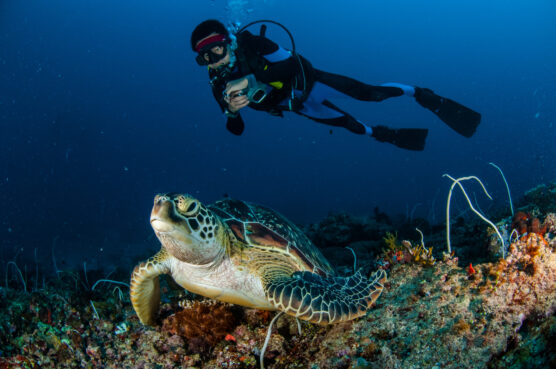
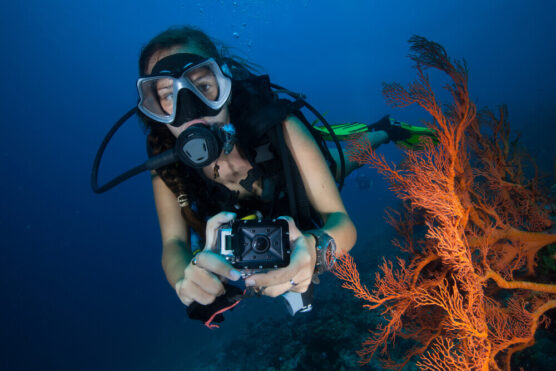
Cheap Diving Camera Specs and Terminology:
1) Underwater Photography
When it comes to shooting great underwater photos and avoiding the common downfalls that result in less great ones, there’s a few strategies you’ll want to remember. To find out more take a look at our article: “Underwater Photography Tips for Beginners“.
2) Underwater Housing
When we refer to underwater housing we’re talking about the protective outer casing that cameras must be placed in to make them waterproof.
Most “underwater cameras” are action cameras that include underwater housing, which usually makes them waterproof to 133ft. Outside of their casing they are either not waterproof at all or only waterproof to about 33ft.
3) Action Camera
A compact and generally low cost camera that’s packed with a range of accessories such as a wrist strap, remote control and accessories to let you attach the camera to helmets, handlebars etc and of course underwater housing, so it can be taken underwater.
Action cameras universally feature image stabilisation. As well as being used for diving, their also prized for recording other fast movement activities such as skating, biking and paragliding.
Most of the cheap diving cameras we’ve reviewed here are action cameras (the exceptions being the SeaLife Micro 3.0 and the Olympus Tough).
Generally speaking, action cameras primary source of control is via a touchscreen, however when encased in it’s waterproof housing, the action cam’s touchscreen cannot be used and so instead, it must be operated via one to two buttons through the waterproof housing.
4) Optical Zoom Lens VS Digital Zoom
Whereas some cameras are described as having a digital zoom, this isn’t something to get overly excited about. Digital zoom is just a glorified crop, you simply blow up an image but don’t get any extra detail!
Optical zoom, on the other hand is the real deal – this is where the physical properties of the lens actually magnify objects and therefore do provide extra detail! The only cheap dive camera with an optical zoom is the Olympus TG-7.
5) 4K Video
Nowadays, being able to shoot in 4K video is very much the benchmark for what is considered good video capability. 4K refers to the approximately 4000 worth of pixel width within the image.
If a camera can’t even shoot 4K, don’t bother with it – it’ll be terribly outdated compared to newer models!
6) MP Sensor
A megapixel (mp) is a million pixels – the term not only used for the number of pixels in an image but also for the number of image sensor elements.
The more megapixels a camera has in it’s mp sensor, the more detail it can capture in an image. So a 16 mp sensor can capture a more detailed image than a 12 mp sensor.
However, whilst a high mp sensor does mean better photo quality, it can actually detract from video recording quality due to making footage more noisy.
Therefore, an underwater camera that is good for both photos and videos, should have a decent number of – but not too many megapixels. A 16 to 20 mp sensor will be ideal.
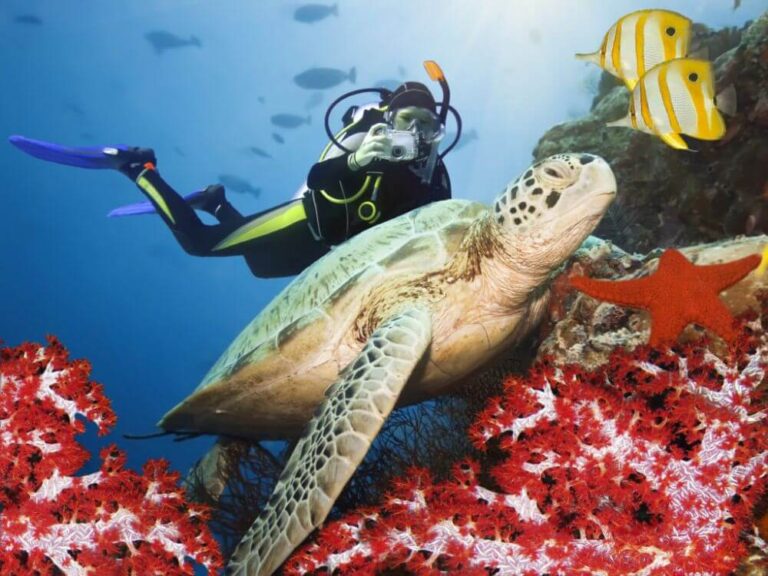
Diving Squad Debriefing
And that’s it. We’re done. The articles over. We truly hope you’ve found this to be a useful and eye opening read and that you’re feeling ready to get out there and purchase your dream cheap underwater camera.
The take home message: It doesn’t matter if you’re low on cash – in today’s society, technology has and still is accelerating so much, that you can now buy the best budget underwater camera to immortalise your scuba adventures for less than $100. How awesome is that?!
Diving Squad Out.
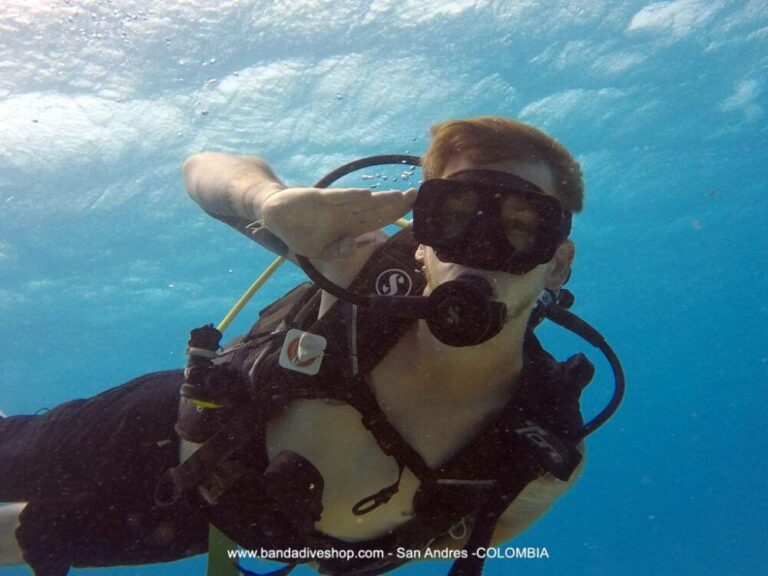
Support the Squad!
We are part of the Amazon Services LLC Associate Program. If you make a purchase on amazon after clicking a link on Diving Squad, we earn a small commission fee, at no extra cost to yourself.
We are also part of several other affiliate programs so if you click on a Diving Squad affiliate link that results in you booking a liveaboard, booking accommodation, purchasing insurance or buying a product somewhere else, once more we make a small commission, without it costing you a cent extra. Thanks!
Written by:
Alex
